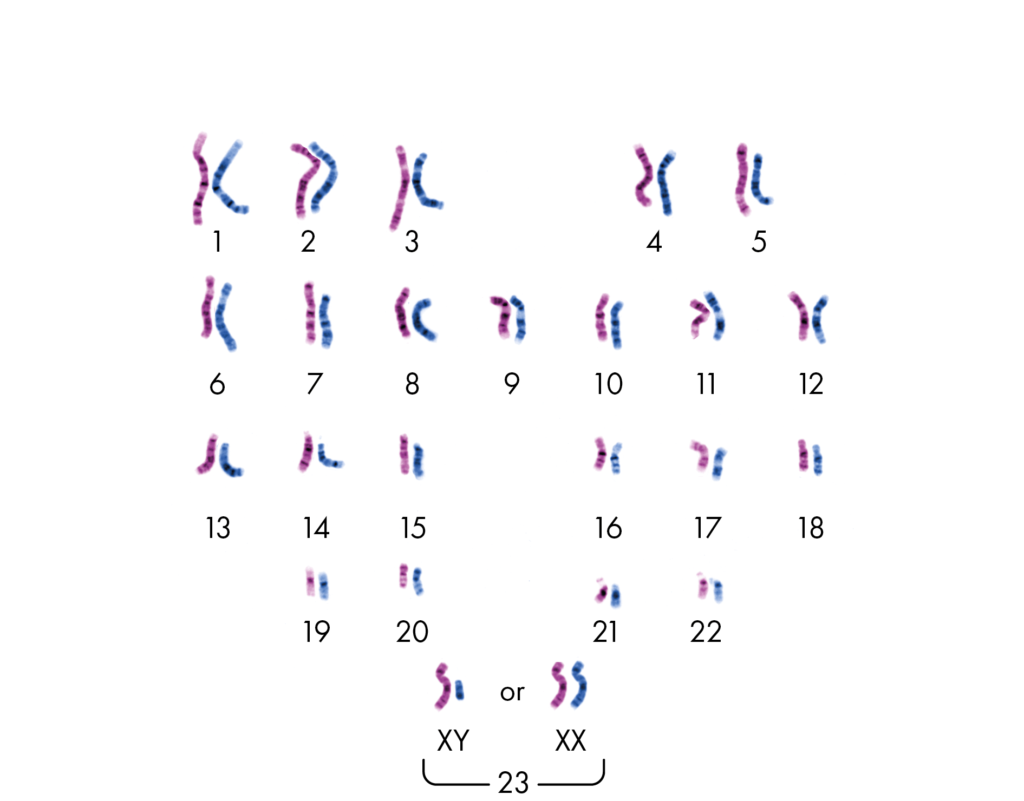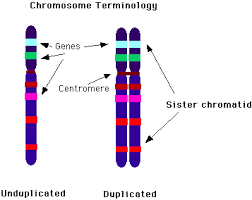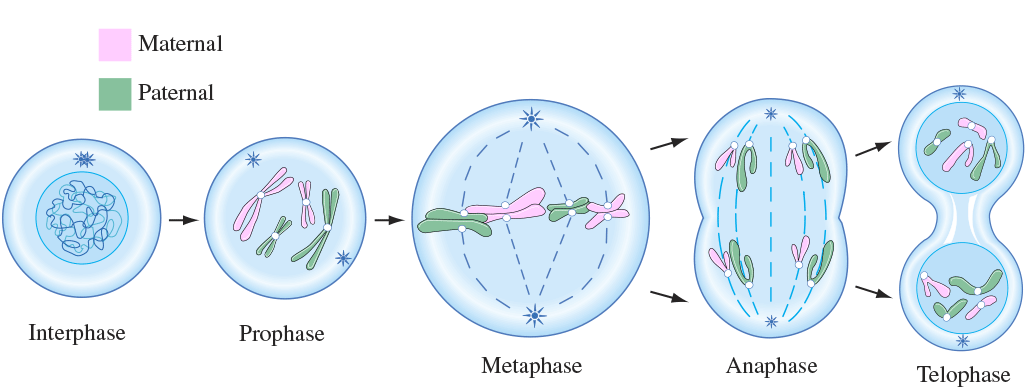Genetic Information and Division
Chromosomes
You will need to be able to:
- Explain what a chromosome is.
- Explain what a gene is.
- Understand how many chromosomes are in the nucleus of a cell.
Most of your cells contain a nucleus, where your genetic material is stored as DNA. DNA is a long strand of genetic code (which you will learn more about later). The long strand of DNA is coiled up to form a chromosome.
Each cell (apart from egg and sperm cells) contains 23 pairs of chromosomes in their nucleus (so there are 46 chromosomes all together). All of these chromosomes are different, with the 23rd pair being different in men and women. Men have one X and one Y chromosome, whereas women have two X chromosomes.
Genes
A __gene is a section of DNA __which defines something of your character. For example, one gene will define your hair colour, another will define the colour of your eyes. There is a large number of genes within each chromosome.
Mitosis 1
You will need to be able to:
- Understand what a cell cycle is.
- Describe how cells divide in terms of cell growth, replication and mitosis.
Mitosis __is when a __cell reproduces itself by dividing into two identical cells. It does this in a series of stages known as the cell cycle. The cell cycle starts with cell growth and DNA replication and ends with mitosis (cell division).
Growth and replication:
- Before the cell starts to divide, the __DNA __is __spread __out in long strings (not wrapped up like a chromosome - take a look at the ‘interphase’ part of the picture below).
- The cell then duplicates all of its organelles (mitochondria and ribosomes etc).
- It then duplicates its DNA. To do this the DNA forms into chromosomes and then duplicates each arm, to look like an X.
Mitosis
Mitosis is when the cell actually divides.
- The chromosomes line up along the centre of the cell. Cell fibres attach to the two centre of each replicated chromosome and pull the two apart.
- Membranes form around the parted chromosomes, these become the nuclei of the two daughter cells.
- The cytoplasm and cell membrane now divide, creating two identical cells to the parent cell.
Mitosis 2
You will need to be able to:
Recognise mitosis from pictures of real cells.
Explain what is happening in each picture.
Calculate how long it takes a part of the cell cycle to complete.
You can clearly see the X-shaped chromosomes in these pictures. Here is what is happening in each picture.
Picture 1 - Chromosomes have duplicated.
Picture 2 - The chromosomes line up along the centre of the cell.
Picture 3 - The cell fibres pull apart the chromosomes.
Picture 4 - The cell fibres pull apart the chromosomes (still).
Picture 5 - A membrane forms around the two sets of chromosomes to form two daughter cells.
How to calculate the time of each stage in the cell cycle
The time taken for a stage of the cell cycle changes depending on the type of cell and the environmental conditions. You will need to calculate how long each stage takes, when given the right information to work with).
Example:
A scientist observed some dividing cells under a microscope and takes a picture. She counts 100 cells in the picture, 30 of which are in the division stage of the cell cycle. She already knows that one full cycle takes 24 hours to complete. How long does the division stage last?
Answer:
Of all the 100 cells, 30 of them are dividing when the picture was taken. We can assume that the proportion of time spent dividing was 30th/100 of the cell cycle.
The cell cycle takes 24 hours, so the division time is:
Binary Fission
You will need to be able to:
Describe the process of binary fission in prokaryotic cells.
Calculate how many bacteria cells there are after a certain amount of time, given the necessary information.
Prokaryotic cells, such as bacteria, divide in a slightly different way, this is called binary fission.
This happens in five steps, as follows:
- The plasmid(s) and circular DNA replicate.
- The strands move to the opposite sides of the cell as the cell expands.
- Cytoplasm begins to form and the two daughter cells start to form.
- The cell membrane fully forms and the two cells move apart.
- There are now two daughter cells, with the same amount of circular DNA as the mother cell, but may have a different amount of plasmid copies.
Bacteria can divide very quickly when they’re comfortable (in the right conditions). This environment is usually warm, damp and contains lots of available nutrients. However, this division can be quickly slowed if the conditions are not favourable, and cells can start dying. This is usually the reason we cook food, to kill the harmful bacteria!
Mean Division Time
The mean division time is just an average of how long it takes for a prokaryotic cell to divide. If you how how many cells you start off with, and the mean division time, you can work out how many cells there are after a certain amount of time.
Example:
There is originally one cell, but the cell is in favourable conditions, making the cell mean division time 30 minutes. How many cells are there in 5 hours?
Answer:
Work out how many minutes have passed:
Calculate how many times the cells have divided in that time:
Now all you have to do it times 2 by itself as many times it has divided:
- What is a chromosome?
- Your answer should include: Coiled / Up / Strand / DNA
- What is a gene?
- Your answer should include: Section / DNA / Codes / Specific / Feature / Organism
- How many chromosomes in a human skin cell?
- Your answer should include: 46 / 23
Explanation: 46 chromosomes or 23 pairs. - How long is the replication phase if a picture of 30 cells shows 4 cells replicating. The cell cycle lasts 20 hours.
- 160











